Thinking of joining the revolution and buying a motorhome or campervan? We have wrote this comprehensive guide covering all the tips you need to know about buying a motorhome or campevran.
We curated this guide based on our first-hand experience of buying several motorhomes and campervans along with curated tips from the vanlife community so lets dive in!
If you are also considering whether a caravan might be for you, you might want to check out our guide: Caravan vs Motorhome: Which One Should You Buy?
Jump to
Types of Motorhomes and Campervans
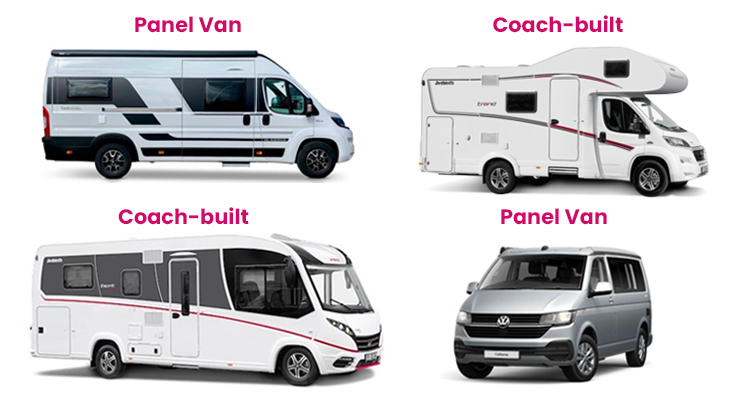
Spending plenty of time on research will save you a lot of hassle in the long run. It took us 4 purchases before we found the right motorhome to suit our family needs so hopefully spending more time on researching specs, layouts and different types will save you this hassle.
First of all, it’s important to note there are two main types of motorhome and campervan:
Panel Vans
When you think about buying a campervan, this is the type of vehicle you would picture in your head. Panel Van campervans start life as a standard commercial panel van you see on the roads everyday. They are purchased by manufacturers or conversion companies as a standard commercial panel van and then are converted into a motorhome by adding windows and the interior into the rear shell. Panel vans is where the term ‘campervan’ really came from where as the term ‘motorhome’ is usually referred to coach-built.
Coach-built Motorhomes
Coach built motorhomes are also derived from standard commercial van chassis but instead, they are purchased by motorhome manufacturers just with the cab and chassis, no panel van shell or construction on the rear. The manufacturers then add on their own structure design on the read which is usually more square and boxy in shape giving them more interior room in terms or width and height.
Motorhome and Campervan Layouts
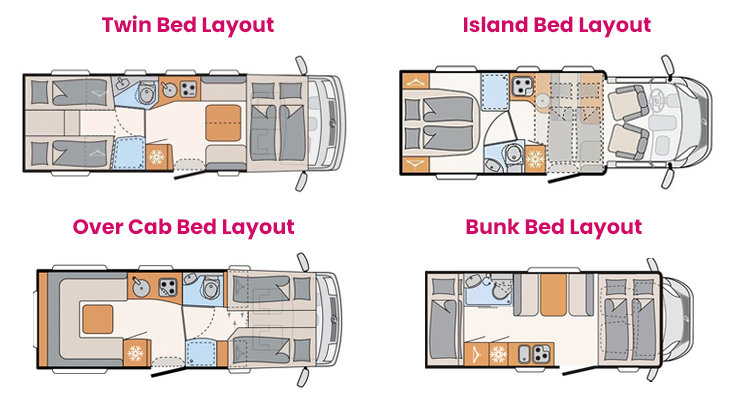
Once you know whether you are looking to buy a campervan or motorhome, it’s time to think about how many people will be travelling and sleeping in the van. The number of occupants you need to house will really lead the research in the types of layout that will be most suited to you.
When considering layout options, you have to really focus on the sleeping arrangements first. Here are some common sleeping layouts:
Twin bed rear layout
As you can imagine, this will usually include twin single beds in the rear that can sometimes be converted into a large double bed. The twin bed layout option is handy for when one person needs a trip to the toilet or bathroom in the night without disturbing the other person. Twin beds layouts are not necessarily 2 berths either. Sometimes the dinette in the front can be converted to a 3rd single bed or if you have an A Class motorhome, there is sometimes a drop down double bed option at the front to accommodate a further 2 adults comfortably.
Island bed layout
Island bed layouts are becoming an increasingly popular choice for motorhomes but not necessarily something you find in panel van campervan conversions. An island bed layout is as it sounds. To the rear of the motorhome you’ll find an island bed in which you can access the bed both from the bottom and both left and right sides. You’ll usually also find a wardrobe either side of the bed. Again island bed layouts are not necessarily just 2 berth options, just like the twin bed layout, usually the dinette area can turn into a single bed or with an A Class motorhome you can get a double drop down bed at the front.
Overcab bed layout
Overcab bed layouts are found in coachbuilt motorhomes where the bed is situated over the driving cab area. This can add extra height to a motorhome but it does open up a lot more living space area in the rear of the motorhome which is great for families. Overcab bed layouts also give you a higher chance of having more bed configurations in the rest of the motorhome such as a lounge at the rear which can be turned into a double bed plus the dinette area which can sometimes be turned into a further single or double bed. It’s not uncommon to find this type of layout used in 6 berth motorhomes.
Bunk bed layouts
Bunk beds are not a super common sleeping arrangement to find in motorhomes or campervans but are great for families who may have older kids who need their own bed. We’ve seen twin beds in both campervans and motorhomes and are sometimes found at the rear or on one of the sides depending where the main bed is situated.
Pop top roof layouts
Pop top roofs are super popular in smaller campervans like VW T5’s or Vauxhall Vivarios. These extra pop out roofs give the advantage of standing space in smaller height campervans and also another double bed option where you climb up and access the pop top via a small ladder.
Other factors to consider when choosing the perfect campervan or motorhome layout are the positioning of the lounge or dining area. Do you want this at the front which can usually compromise space or would you prefer a U shape lounge usually found in the rear?
Kitchens are almost always found in the middle on newer types of motorhomes and campervans however some older models can have a rear kitchen area.
Think about size, weights and payload
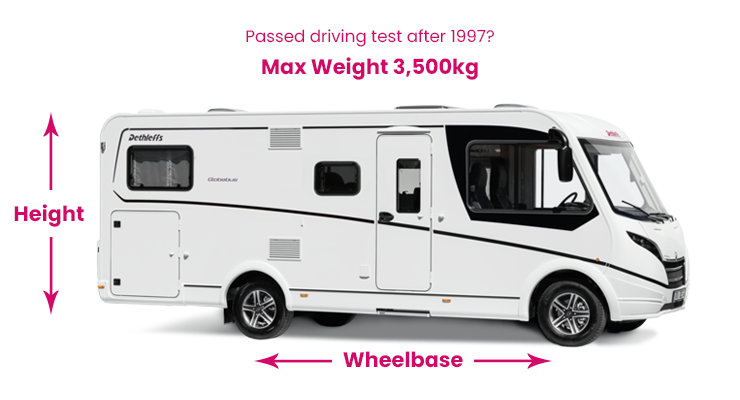
Motorhomes and campervans come in all shapes, sizes and weights. The size you need will usually be dictated by a number of factors such as:
- Do you have the correct license to drive the vehicle?
- Where you want to travel? Driving tiny roads or off-grid locations?
- How many people do you need to carry and sleep?
- How much luggage space do you need?
- Know your payload, it is important.
Do you have the correct license?
Before you dive straight in 2 feet first to buy a motorhome or campervan, this is one thing you can’t really overlook but which many first time motorhome or campervan buyers sometimes do. If you passed your driving test after 1997 then you can legally only drive vehicles up to 3,500kg in total gross weight. If you passed your driving test before this date then you can drive up to 7,500kg. Knowing what license you have will either restrict your search or open up your search but this is a legal requirement and you do need to know this. If you don’t have the license to drive a vehicle over 3,500kg then you can get one by doing your C1 license which requires a medical, theory test and practical test.
Where do you want to travel?
If you plan on driving into to remote places, off-grid locations or down tiny single track roads, then a huge motorhome isn’t going to be the ideal choice for you. Whilst accessing places like this is not impossible in large motorhomes it doesn’t provide it’s obvious challenges therefore buying a small campervan would probably be the better choice here.
How many people do you need to travel and sleep?
The first thing you should take into account is how many people will be travelling in your motorhome or campervan. Once you know this then you need to make sure you have the correct number of belted seats suitable for the journey and also the right number of beds for sleeping space.
Both motorhomes and campervans usually have 4 belted seats for travel but if you are a larger family, some motorhomes now provide traveling seats for up to 6 people.
Top Tip: It’s important to note as we found this out quite quickly. Motorhome manufacturers don’t have to have enough belted seats for travel to match the sleeping capacity. What we mean by this is, it is very possible and quite common to see a 4 berth motorhome but with only 2 travelling belted seats. If you are a family of 4, this will not be suitable as you can only travel with 2 people.
How much luggage space do you need?
Another factor which must be considered when deciding on what size motorhome or campervan to buy is how much luggage and storage space you need? Taking camping chairs, tables, bikes, toys, activities, boots, wellies and other items can take up a huge amount of space let alone weight. Campervans don’t tend to have much storage space however common motorhome layouts tend to have larger garage areas at the back where you can store all these items.
Payloads, payloads, payloads.
Whats a payload I hear you all ask? This is like the offside rule for vans but in all seriousness, this is probably the single most common thing overlooked by newbie campervan and motorhome buyers.
So what is payload? The payload is the carrying capacity of your vehicle. You need to understand essentially, how much your stuff that you take weighs and ensure you don’t load more than the carrying capacity of your vehicle.
Your payload is the difference between the maximum weight of your motorhome (MTPLM, MAM, etc) and what it actually weighs before you’ve added all your kit and accessories.
So to explain a little further in laymen’s terms with an example.
Let’s say you passed your driving test after 1997, this means you can only drive a vehicle up to 3,500kg in weight. When you buy a motorhome or campervan, it will have a weight when empty (sometimes referred to as the kerb weight). This is the weight of the vehicle without anything in it. So if it’s 3,000kg in weight then you have 500kg left to add to that vehicle before you are at your limit of 3,500kg.
Whilst 500kg (half a ton might sound a lot), it can disappear quite quickly. Here’s some quick maths:
The average weight of an adult: 75-85kg
The average weight of a 5 year old: 18-20kg
The average weight of a bicycle: 10-15kg
The weight of water: 1KG for every litre (100 Litres of water = 100KG)
The weight of fuel: 1KG for every litre (100 Litres of fuel = 100KG)
So imagine, 2 X Adults, 2 X Kids, 4 Bikes, 100 Litres if water, 100 litres of fuel. This would equate to potentially 470kg and at this point you havn’t even factored in the weight of the clothes you will take, trainers, camping chairs, tables, food, wine.
To note, motorhome manufacturers now advertise payloads of vehicles and also refer to something called ‘MIRO’ which stands for Mass In Running Order. This is usually the weight which includes a 75kg driver, a percentage of fuel weight and a small percentage of water.
Why are payloads important? Well it’s law. If you are stopped and found to be overweight then you face fines and potential points on your license. Not only that, your vehicle is only designed to carry that weight and therefore you’ll be adding extra pressure on all the mechanical aspects of your vehicle like the tyres, brakes and suspension.
Thinking about payloads can get very stressful, especially if you are restricted to a 3,500kg vehicle but as a side note, in 6 years, we have never been stopped or pulled over in the UK. I’m not condoning you knowingly go over-weight but there are tons of motorhomers, caravanners and campervanners I speak to on a weekly basis who don’t even realise this subject is a thing.
How often will you travel and when?
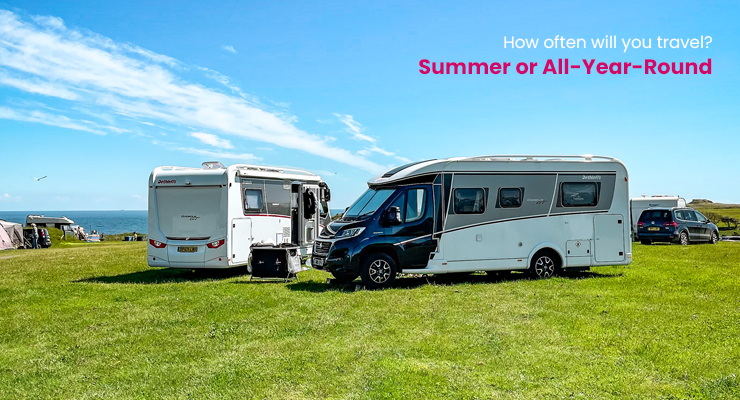
There are some considerations to make here on how often you will be using your campervan or motorhome and also when you might be using it. This is really likely to be the driving force on how much space you actually need.
If you plan on only travelling in the summer months and on weekends then the most popular choice are small campervans. They can be cheaper than coach-built motorhomes and more accessible too. Travelling in the summer months also means you’ll be spending less time inside your campervan and therefore theres less need for lots of space.
On the flip side, if you plan on travelling all year round you might want to consider buying a motorhome or larger campervan that provides more internal space for the times when the weather is bad (quite often in the UK).
Remember that whatever decision you make now, don’t stress over it too much because we have personally changed vans 3 times in 6 years. When we first started out we only wanted something small and then the more we travelled, the more we enjoyed it. We ended up taking much longer trips all year round which meant we just felt like more space was better for us which is why we finally decided on buying our current motorhome.
What facilities do you need?
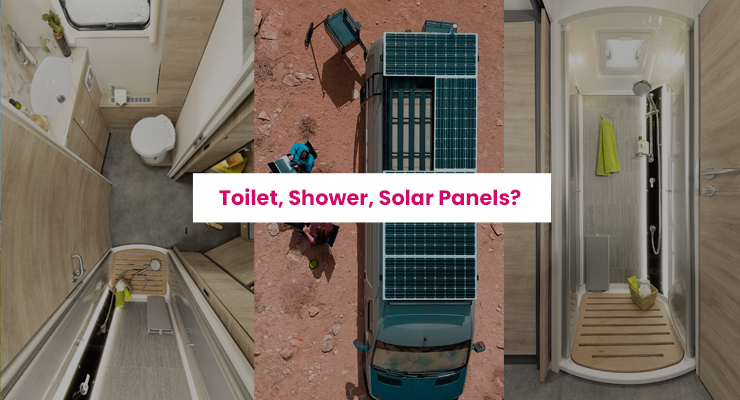
Again this is largely going to depending on your use case however some big considerations to make would be whether you need a toilet, shower and off grid capabilities in your motorhome or campervan. If you plan on visiting only campsites with facilities then you probably don’t need a toilet, shower or even any major off-grid electricity generating capabilities like solar panels. If however you plan to explore far and wide, and do more wild camping as we call it, then having all these facilities on board are going to be way more useful to you but will mean you may need to buy a larger motorhome or campervan.
Do you need off-grid capabilities?
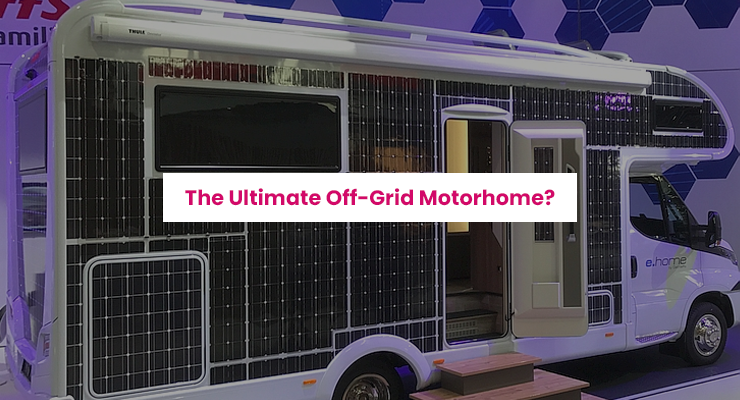
Like we briefly touched upon above, your off-grid requirements are going to be driven by the type of places you are going to visit and stay at in your motorhome or campervan.
If you plan on staying only at campsites with all the facilities you need, then you’ll likely have access to electric hookup so you don’t need to worry about power and also things like fresh water and waste water facilities.
On the flip side, if you are going to do more wild camping not on campsites and maybe pub stopovers which are becoming hugely popular in the UK, then your going to need a good leisure battery and solar panel setup for power and you’re going to need some onboard and waste water solutions.
Building in off-grid capabilities into a campervan or motorhome can be considered during your purchase or retro fitted after by someone competent to do so. If you are purchasing a new motorhome or campervan then these are all options you can spec at the time of ordering.
New or used Motorhome or Campervan?
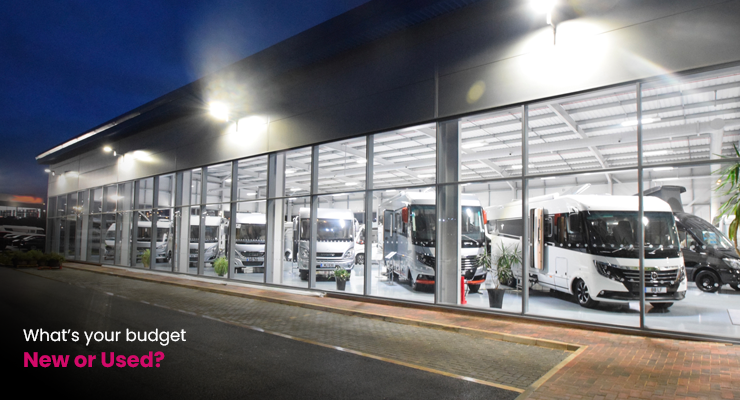
Deciding whether to buy a new or used motorhome or campervan depends on your budget and how much you’re willing to spend. New models are usually more expensive, but they come with a warranty that can be important if something breaks while you’re traveling. Older, used models may seem less attractive at first, but are often cheaper than their newer counterparts and you can get more for your money. Purchasing an older model does come with risks however and it is very wise to ensure you fully inspect the habitation of the vehicle and the mechanical aspects.
You can hire professionals to do this for you for a cost. A mechanic is going to help check out the mechanical condition of the vehicle and asking a seller to obtain a habitation check will ensure that the internal of the living area and all appliances are working safely and correctly.
How should you finance a purchase?
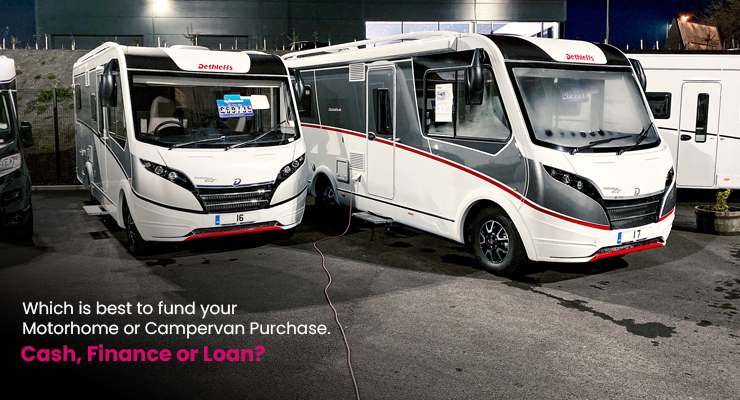
Buying a motorhome or campervan can be expensive and not everyone has the finances to buy one outright.
There are some options you can consider when it comes to trying to finance a motorhome or campervan
- Explore private lenders (like personal loans)
- Finance options from dealers are quite popular
- Funded by savings (if your lucky enough to be able to)
Remember however, motorhomes and campervans are usually depreciating assets. The value is unlikely to go up with the exception for the rise in demand when covid struck, but thats a rare event. Make sure you can truly afford the repayments for the type of vehicle you want. Again finance might be another reason why you have to consider layouts and sizes as mentioned above.
Top Tip: When purchasing using Finance, you are sometimes entitled to more rights compared to when buying with cash or loans. For example, if you have issues with a new vehicle and your not getting the response you’d hope for from your dealer, you can contact your finance company who will usually help to resolve issues on your behalf and sometimes even fight a warranty claim.
Motorhome vs campervan: Pro’s and Cons

Motorhomes and campervans are two of the most popular types of recreational travel vehicles on the market, but how do you know which one is right for you?
To help you decide, let’s take a look at some of the major differences between motorhomes and campervans so that you can make an informed decision about which type will be best suited to your needs:
Motorhome (Coachbuilt) Pro’s:
- Motorhomes tend to be larger with more sleeping and layout options
- Motorhomes usually have more space ideal for all-year-round travelling or living
- Motorhomes can have more storage space like garages at the rear
Motorhome (Coachbuilt) Con’s:
- They can be expensive to buy
- They tend to be a lot larger
Campervan (Panel Van) Pro’s:
- Campervans can be much smaller, great for driving
- Almost always under 3.5t in weight
- Tend to be cheaper than motorhomes for the most part
Campervan (Panel Van) Con’s:
- They’re smaller, less space which can be annoying for all-year-round travel
- Have far less layout options for families
The primary benefit of purchasing a motorhome over a campervan is its size. If space is at a premium and storage is an issue, then buying a larger vehicle might be best for your needs. Additionally, if there are more than two people traveling together or if anyone has mobility issues (such as those with limited leg room), then this may be an important consideration when deciding between these two options.
Conclusion
Buying a motorhome or campervan can be a really daunting task considering the significant financial investment you have to make. Don’t let the research or the options take the fun out of the whole reason you are doing this though. Vehicles are merely objects which are replaceable and they’re only the facilitators of the adventure you are about to embark upon!
We really hope you found this buying guide useful. If you have some tips from any real life experience yourself, please let us know on social media and we’ll be happy to add them to this post and credit you 😊


